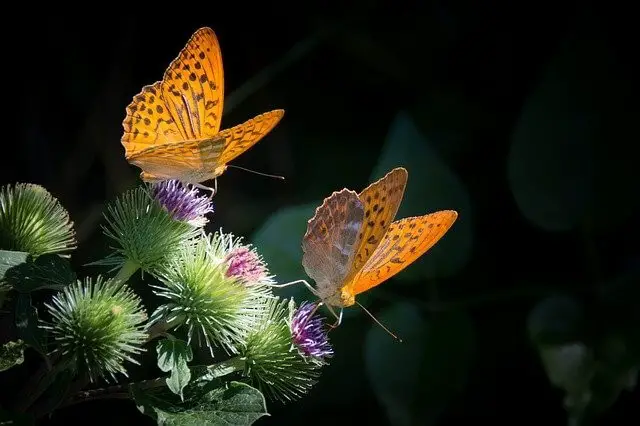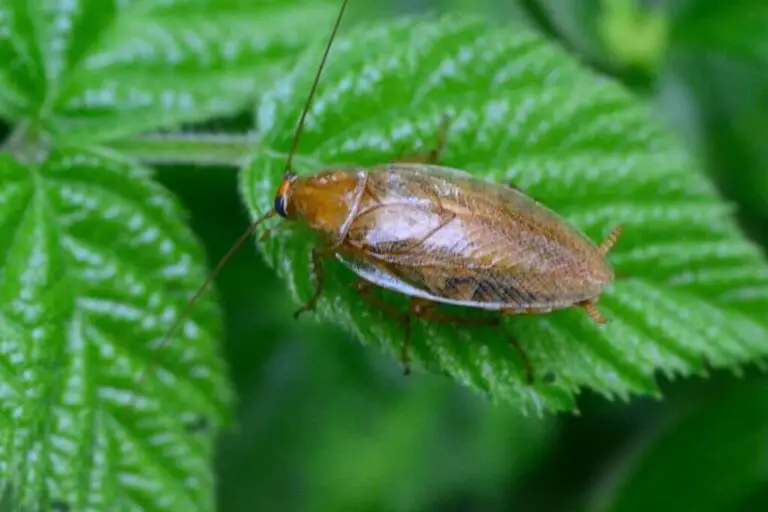25 Beautiful Trees With Yellow Flowers: A Photo Essay (With Pictures)
While many people associate spring with pink and white blooms, there’s another type of tree that steals the show during this time – those adorned with vibrant yellow flowers! These stunning trees can be found worldwide, each with its unique story to tell. In this photo essay, we’ll take a journey around the globe to discover some of the most beautiful examples of yellow-flowering trees.
From the Angel Trumpet Tree in South America to the Tulip Poplar in North America, and from the Sweet Acacia in Africa to the Yellow Tabebuia in Asia, we’ll explore 25 breathtaking species that will make you want to grab your camera and hit the road!
Yellow Flowering Trees Identification.
When it comes to identifying yellow flowering trees, one of the biggest challenges is the sheer variety of species. To make things more manageable, consider the following key characteristics: the shape and size of the leaves, whether the tree is evergreen or deciduous, its overall height, and the texture of its bark. By taking a closer look at these features, you’ll be better equipped to narrow down your options.
Of course, there’s always room for error, but having a solid understanding of these basics can go a long way in helping you pinpoint the correct species. If you’re still stumped, don’t hesitate to consult a field guide or seek the expertise of a local nursery or extension office by bringing along some samples of leaves or flowers.
25 Beautiful Yellow Flowering Trees
Angel Trumpet Tree (Tabebuia roseo-alba).
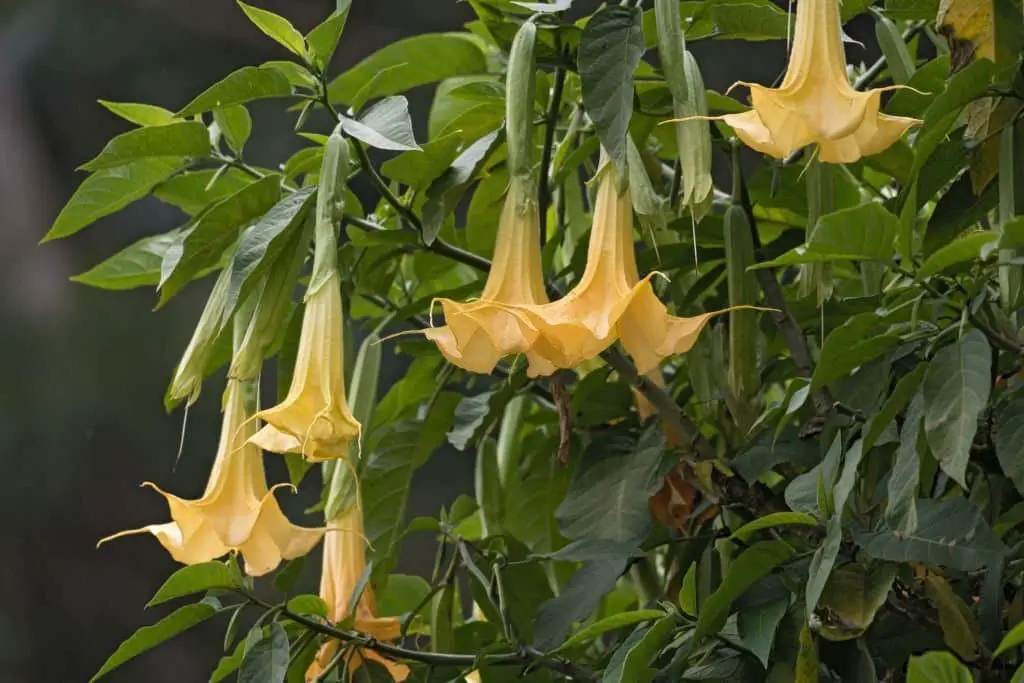
The majestic bloom of the tree is a sight to behold, with trumpet-shaped flowers that radiate beauty and fragrance. The vibrant hues of white or yellow add an extra layer of allure, while the clusters they form create a visually stunning display. Meanwhile, the tree itself stands tall, reaching heights of up to 30 feet, its grandeur undeniable. Native to Brazil, this remarkable species has also taken root in many other countries around the world, showcasing its adaptability and resilience.
Cassia Tree (Senna polyphylla).
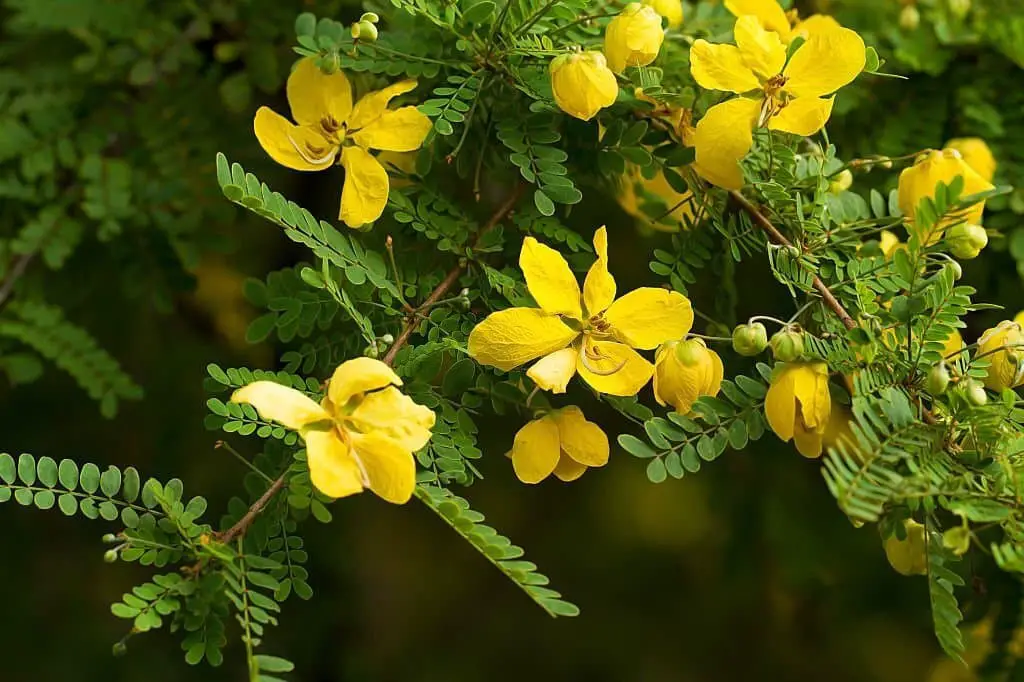
For those looking to inject a splash of vibrant color into their outdoor space, the Cassia Tree is an excellent choice. Native to tropical America, this striking tree thrives in dry open areas, reaching heights of up to 20 feet tall and boasting pinnate leaves featuring 11-19 pairs of leaflets. When it comes to blossoms, the Cassia Tree truly shines, producing bright yellow flowers that appear in clusters along its axillary or terminal racemes.
The real showstopper, however, is the tree’s fruit – a dark brown, woody pod packed with several seeds. Whether you’re seeking to add visual interest to your landscape or simply want to bring some tropical flair to your yard, the Cassia Tree is definitely worth considering. As long as your local climate aligns with this tree’s preferences, you won’t regret giving it a spot in your outdoor space.
Chinese Flame Tree (Koelreuteria bipinnata).
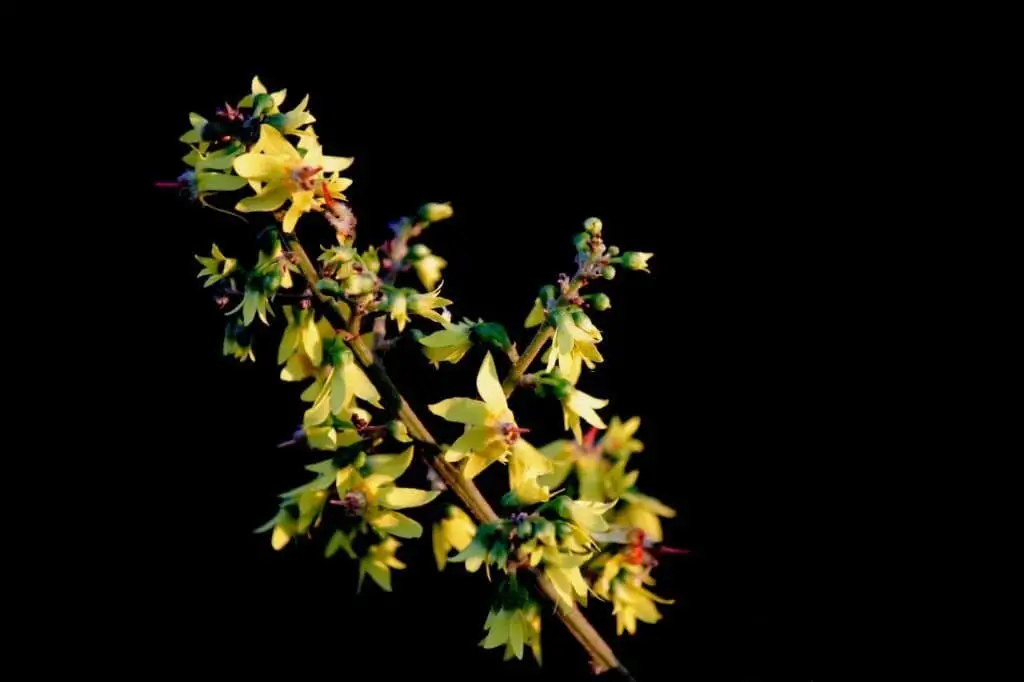
With its striking features, the Chinese Flame Tree (Koelreuteria paniculata) is a deciduous tree that hails from China. This attractive specimen grows up to 20-30 feet tall, boasting pinnate leaves with a vibrant green hue. As summer approaches, the tree bursts forth with bright yellow blooms, which are subsequently followed by brown, woody seed pods. Notably, the Chinese Flame Tree is renowned for its hardiness in dry conditions and low maintenance requirements.
Its natural tolerance to drought, combined with its resistance to pollution and modest water needs, make it an ideal choice for urban landscapes.
Cornelian Cherry (Cornus mas).
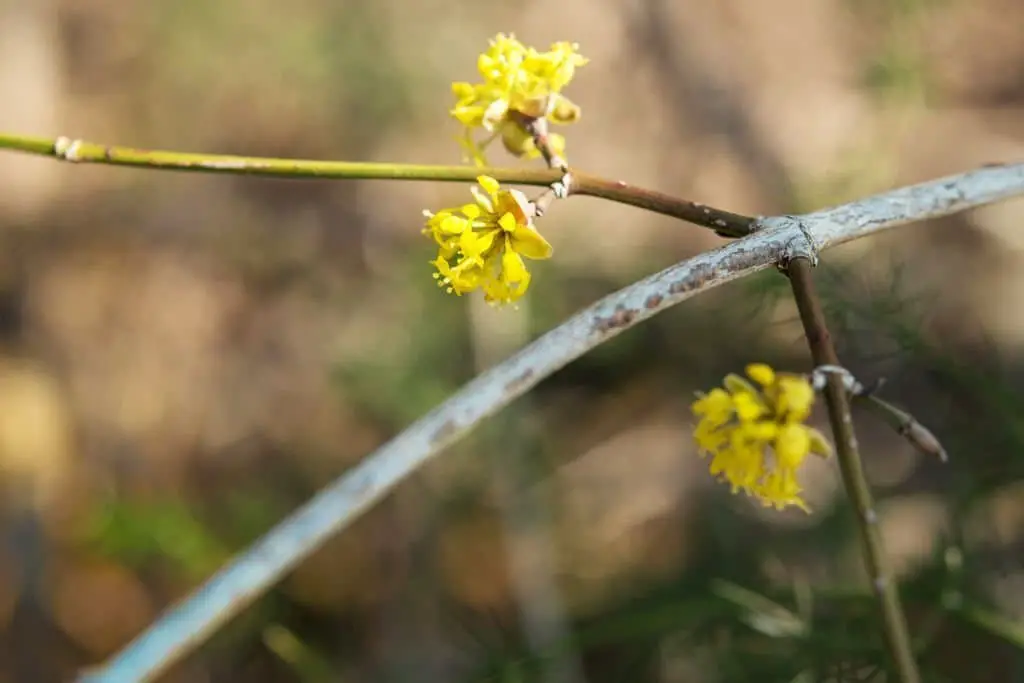
With a maximum height of 15-20 meters (50-70 feet), the Cornelian cherry is a deciduous tree that boasts bright yellow flowers with four petals. When ripe, its fruit takes on a striking red hue and contains a large stone, making it a fascinating sight in any garden setting. Native to southeastern Europe and southwestern Asia, this species can be found from the Balkans to Kazakhstan, where it has been a staple food source for centuries.
In fact, countries like Albania, Bosnia and Herzegovina, Bulgaria, Croatia, Montenegro, Romania, and Serbia have long valued the Cornelian cherry as an integral part of their culinary traditions. Not only is this tree a popular choice among gardeners looking to add some ornamental flair, but it has also given rise to various cultivars featuring diverse flower and fruit colors.
As for its common names, the Cornelian cherry is often referred to as cornel cherry, dog-wood cherry, or European cornel – though it’s essential to distinguish it from its North American counterpart, Cornus florida, also known as flowering dogwood.
Forsythia (Forsythia x intermedia).
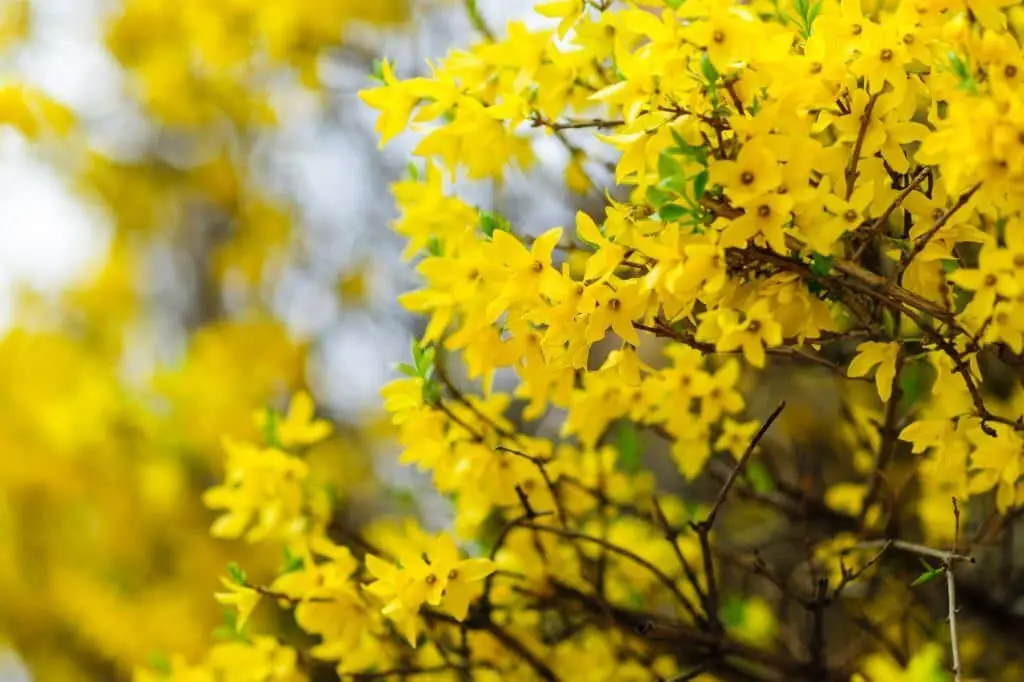
Forsythia, with its vibrant yellow blooms, is an early riser when it comes to springtime beauty. As one of the first shrubs to burst forth with flowers, it’s a surefire way to kick off the growing season on a bright note. Its sunny hues are a stunning addition to any landscape, making it an excellent choice for anyone looking to add a pop of color to their outdoor space.
Golden Chain Tree (Laburnum anagyroides).

The Golden Chain Tree is distinguished by its vibrant yellow blooms, which emit a sweet fragrance. Originating from Europe and Asia, the tree has since spread to other regions globally. Its stature can reach up to 30 feet tall, making it a noticeable presence in any landscape. While full sun is ideal, these trees are adaptable to partial shade conditions. Furthermore, they exhibit remarkable resilience when it comes to soil types, requiring minimal maintenance to thrive.
Golden Raintree (Koelreuteria paniculata).
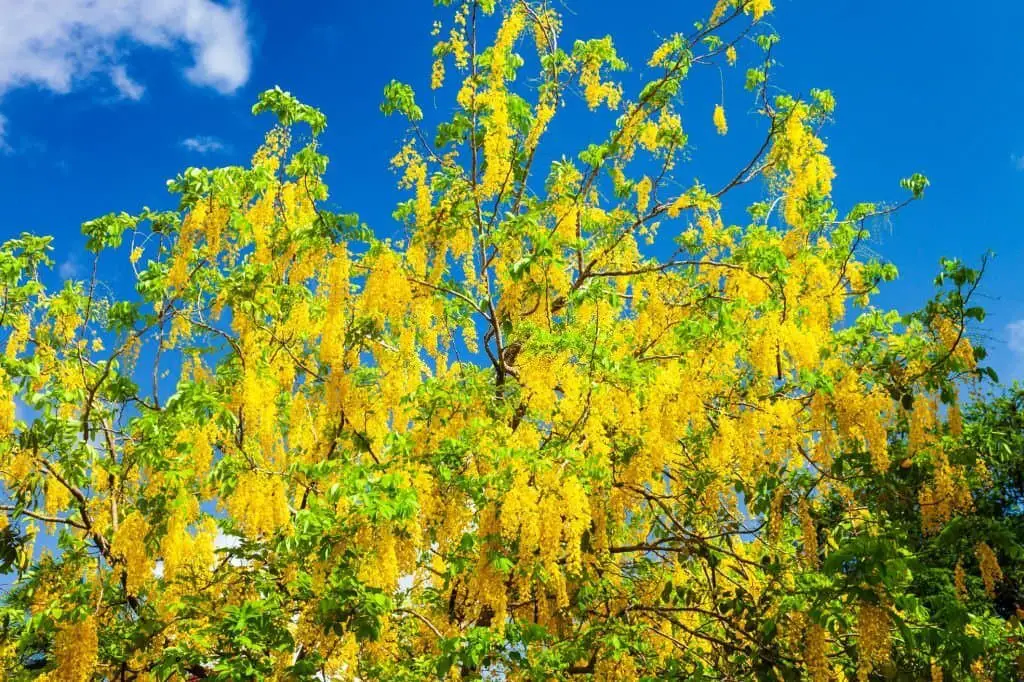
The Golden Rain tree’s vibrant yellow blooms are a delightful harbinger of early summer’s arrival. As a deciduous tree, it’s relatively low-maintenance and adaptable to a broad spectrum of soils. Native to China and Korea, these trees have been widely planted in the United States for their ornamental value. While generally trouble-free, Golden Rain trees can be susceptible to a few issues.
Pests like aphids, scale insects, and leafhoppers may feed on the leaves, causing them to turn yellow or brown and potentially leading to premature defoliation. Furthermore, spider mites may also target these trees, resulting in fine webbing on the leaves and branches, followed by yellowing or browning of the leaves and early leaf drop.
Golden Shower Tree (Cassia fistula).
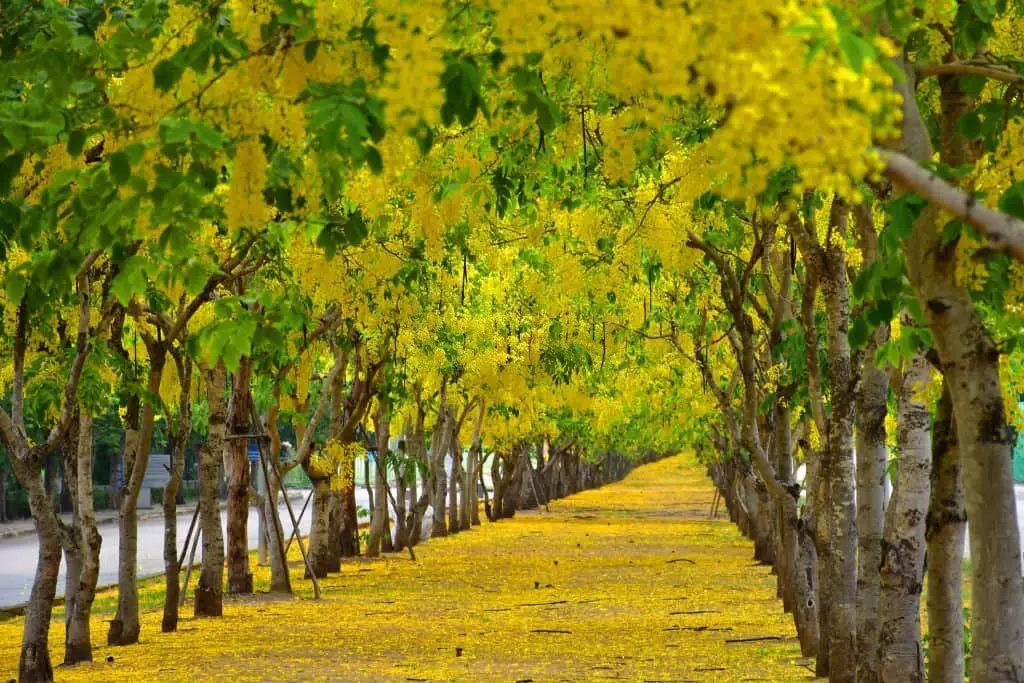
This majestic tree is renowned for its stunning flowers, boasting a vibrant yellow hue and an intense aroma that’s hard to ignore. Native to the regions of India, Sri Lanka, and Myanmar, it also thrives in other parts of Asia, including China and Vietnam. Standing tall at 15-20 meters (50-70 feet) in height, the tree’s leaves are intricately arranged as pinnate clusters, comprising 20-40 pairs of leaflets.
The show-stopping flowers appear in axillary racemes, showcasing a radiant yellow or orange color palette. When mature, the fruit pods transform from green to a deep brown hue, while the blooming period typically spans February to April.
Golden Trumpet (Allamanda cathartic).
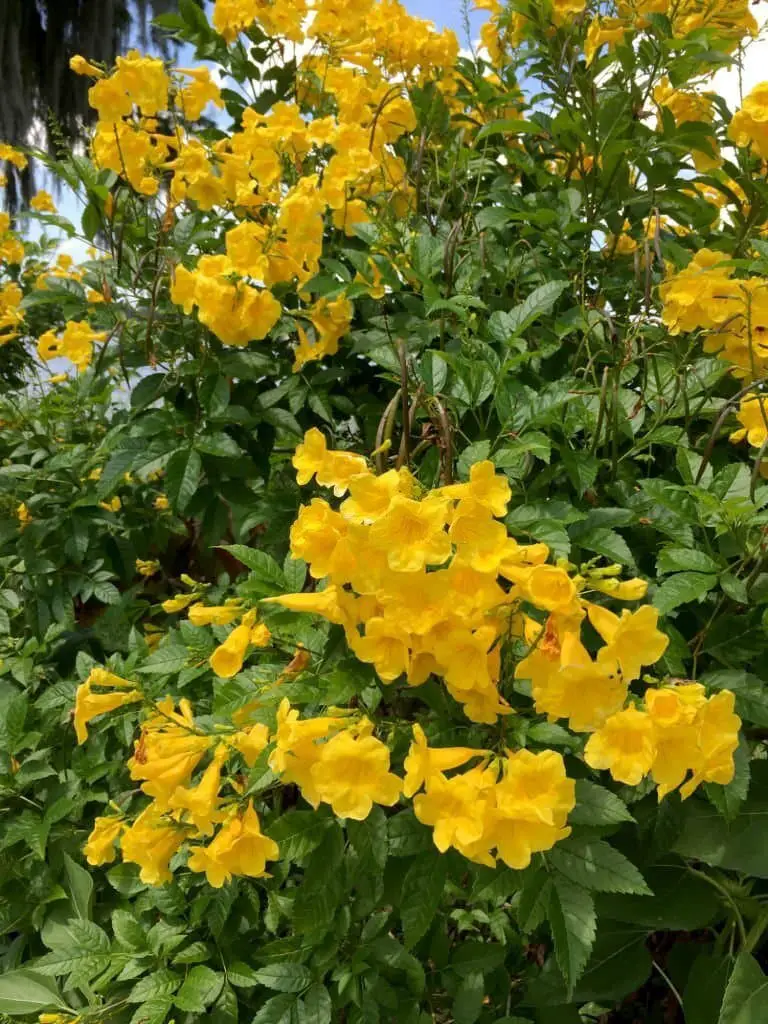
With their five-inch diameter blooms and sweet fragrance, the flowers of the Golden Trumpet are a treat for the senses. Blooming from late spring through summer, this stunning plant reaches heights of 15 feet and retains some foliage year-round in warm climates. It’s an ideal choice for training onto a trellis or arbor. Native to Brazil, but now cultivated worldwide, the Golden Trumpet has become a beloved addition to tropical and subtropical gardens.
While it thrives in full sun, it can tolerate partial shade. Moreover, it is adaptable to various soil types as long as drainage is good. What’s more, this low-maintenance plant is naturally resistant to pests and diseases, making it a great option for gardeners of all levels.
Hearts of Gold Redbud (Cercis canadensis ‘Hearts of Gold’).
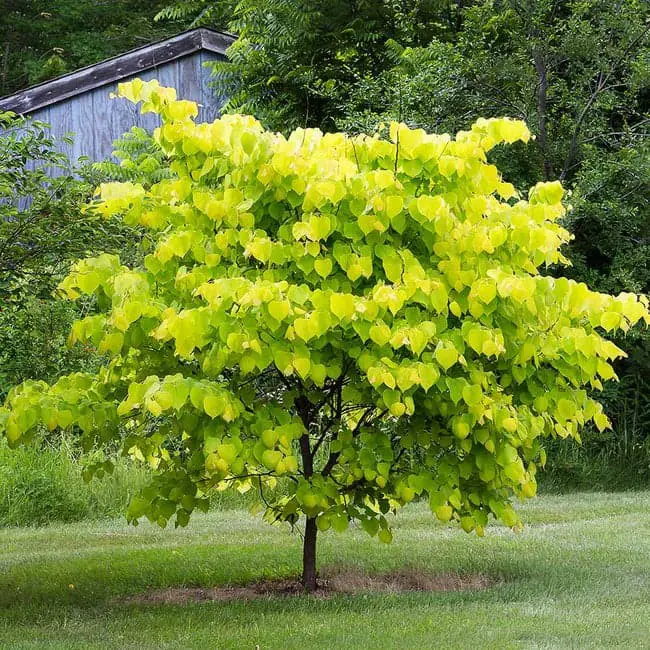
This stunning tree boasts an array of striking features that make it a standout in any outdoor space. Its heart-shaped leaves, which radiate a warm golden hue, are the source of its common name. But that’s not all – the blooms of this North American native are also a vibrant deep yellow, adding an extra layer of visual appeal to its overall charm.
As if its aesthetics weren’t enough, the tree is also surprisingly compact, reaching heights of just 20 feet, making it an ideal choice for smaller yards and gardens.
Julia Child Rose Tree (Rosa floribunda ‘Julia Child’).
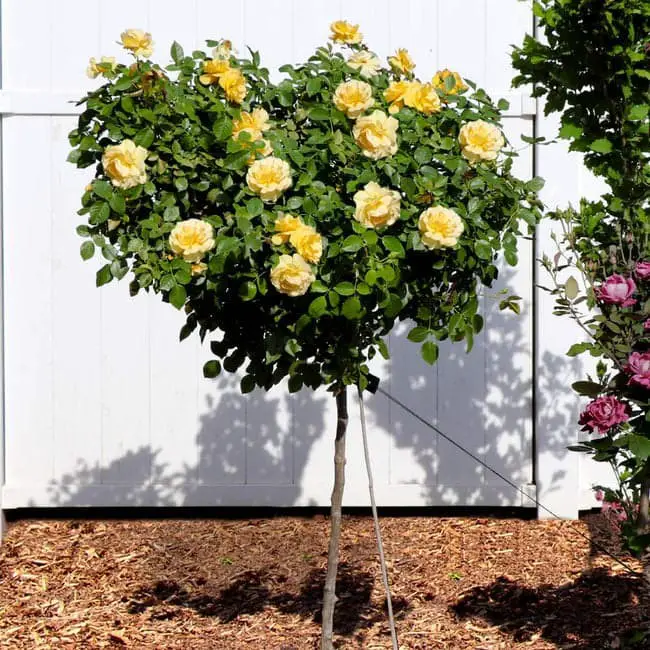
The Julia Child rose, a deciduous shrub, can reach heights of up to 12 feet. Its vibrant yellow flowers, featuring double petals, bloom throughout the summer and fall seasons. The leaves are a deep green hue, with a glossy finish. Named after the renowned chef Julia Child, this disease-resistant variety is also remarkably easy to care for, making it an excellent choice for gardeners of all skill levels.
Whether you’re looking to add a pop of color to your outdoor space or seeking a low-maintenance option, the Julia Child rose is an ideal selection.
Kousa Dogwood (Cornus kousa).
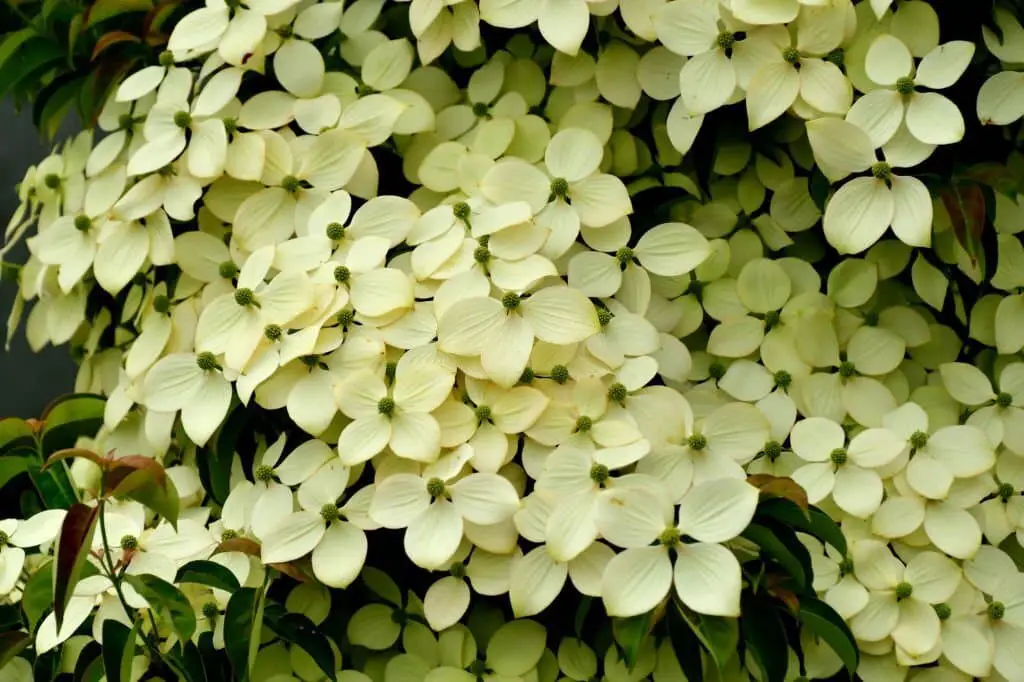
The Kousa dogwood is an understated gem from Asia, growing 15-20 feet tall with a spread of 20-30 feet. Its leaves are the real showstoppers – ovate in shape and measuring four to six inches long, they’re arranged alternately on the stem and boast a deep green hue with a lighter midrib. As spring gives way to summer, this tree bursts forth with clusters of white or pink flowers, a true delight.
But it’s the fruit that really sets the Kousa dogwood apart – small, red berries borne in twos and threes that may be edible but are hardly a treat. Nonetheless, this unassuming tree is a charming addition to any landscape.
Magnolia ‘Butterflies’ Tree (M. acuminata x M. denudata).
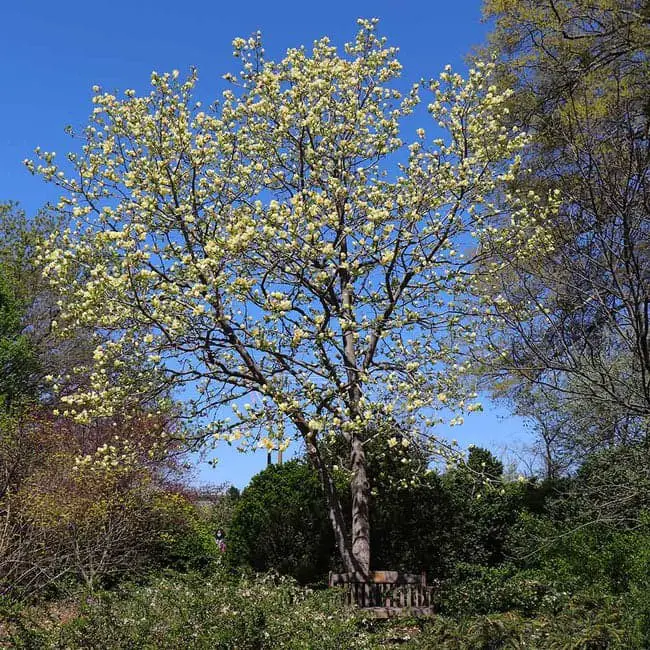
This remarkable hybrid magnolia, known as the ‘Butterflies’ tree, stands tall at up to 30 feet high. Its vibrant yellow flowers are characterized by an impressive 12-16 petals and exude a sweet lemony aroma, blooming beautifully in early spring. As a deciduous tree, it thrives in a variety of conditions, tolerating cold temperatures and doing best in full sun to partial shade.
This versatile tree is an excellent choice for smaller yards or as a striking specimen piece, adding a touch of elegance to any outdoor space.
Oregon Grape (Mahonia aquifolium).
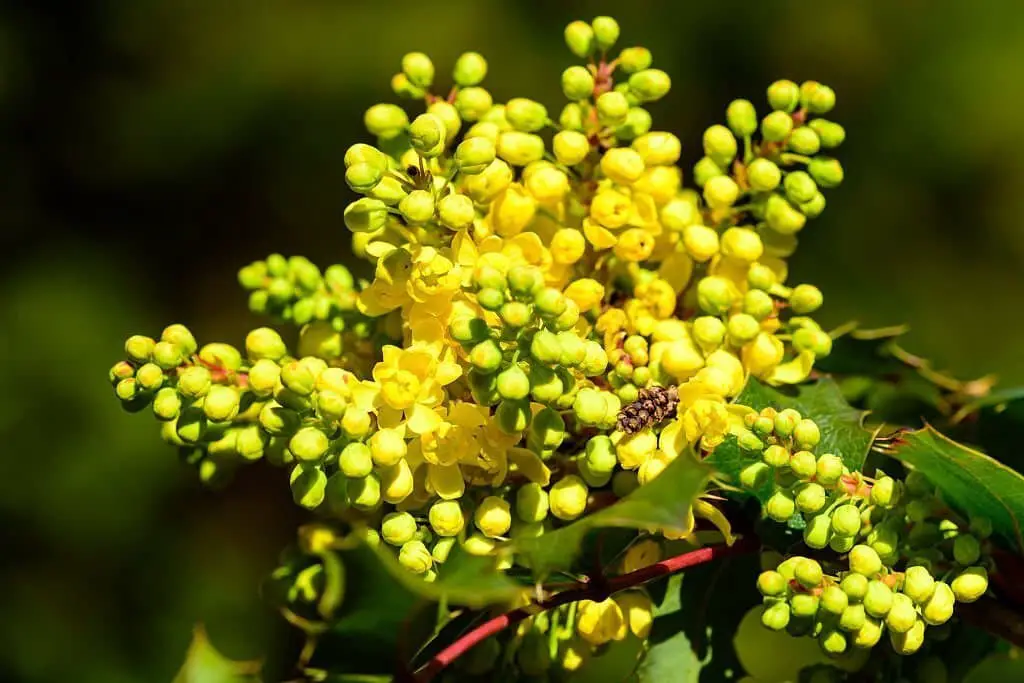
Characterized by its dark green, glossy foliage and vibrant yellow blooms, the Oregon grape (Mahonia aquifolium) stands tall at up to six feet in height. This evergreen shrub thrives in the Pacific Northwest’s forests, woodlands, and riparian zones, where it has evolved as a native species. Notably, the Oregon grape plays a vital role in supporting local wildlife populations. Its fruit, which ripens into juicy berries, serves as a coveted food source for birds and small mammals alike.
Meanwhile, its leaves offer sheltered habitats for birds and insects to take refuge. Furthermore, the Oregon grape acts as a host plant for several butterfly species, providing sustenance for their caterpillars.
Palo Brea (Parkinsonia praecox).
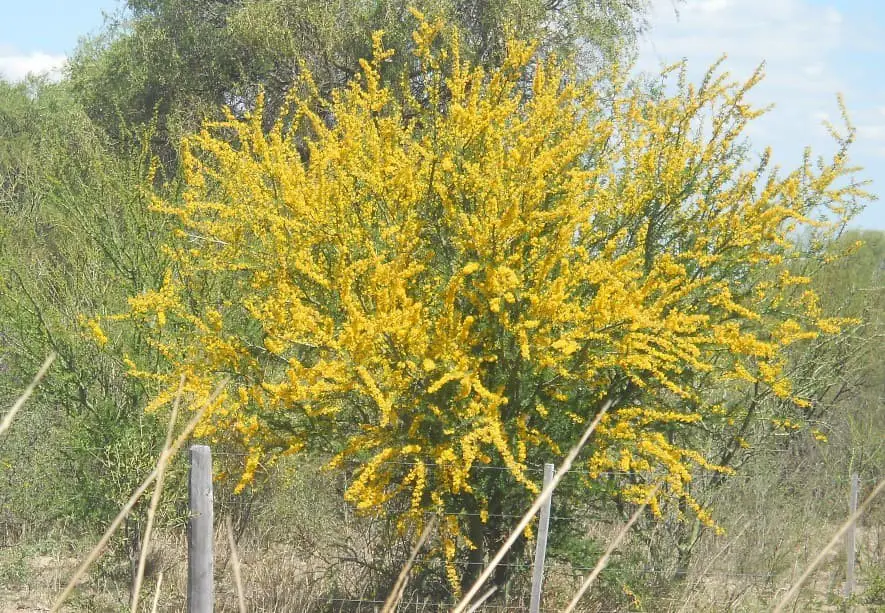
Palo Brea, a drought-tolerant evergreen, can grow up to 30 feet tall, its yellow blooms unfolding between March and April. Native to Mexico and Central America, this versatile tree has also taken root in the southwestern United States. Beyond providing welcome shade, Palo Brea is prized for its woodwork applications and boasts a range of medicinal properties. Moreover, it plays a vital role as a food source for bees and other pollinators, highlighting its ecological importance.
Palo Verde (Parkinsonia Florida).
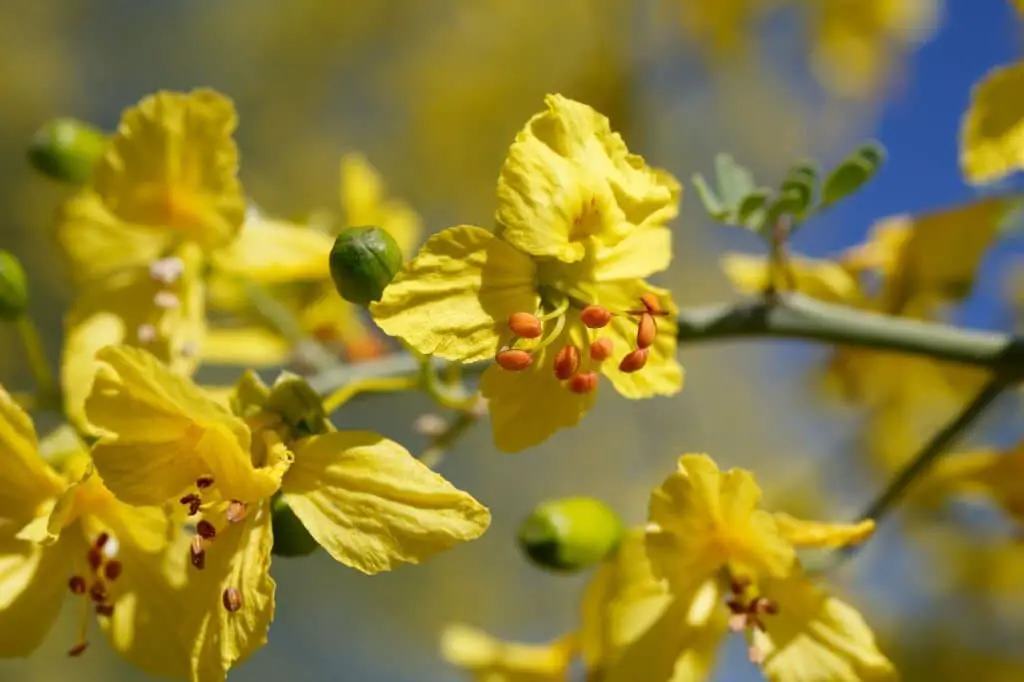
The Palo Verde tree, a small to medium-sized evergreen, boasts a distinctive yellow-green trunk and branches. Its leaves, with a subtle paler underside, are a vibrant green hue. The bright yellow flowers give way to brown or black fruit, adding a pop of color to the desert landscape.
Hailing from Mexico and the southwestern United States, this resilient tree thrives in arid regions at elevations reaching up to 2000 meters.
Its natural habitat is the Sonoran Desert, where it plays a crucial role as a vital source of sustenance and shelter for various desert creatures. Furthermore, the Palo Verde tree has been used by indigenous communities as a traditional medicine, highlighting its cultural significance within the region.
Peltophorum (Peltophorum pterocarpum).
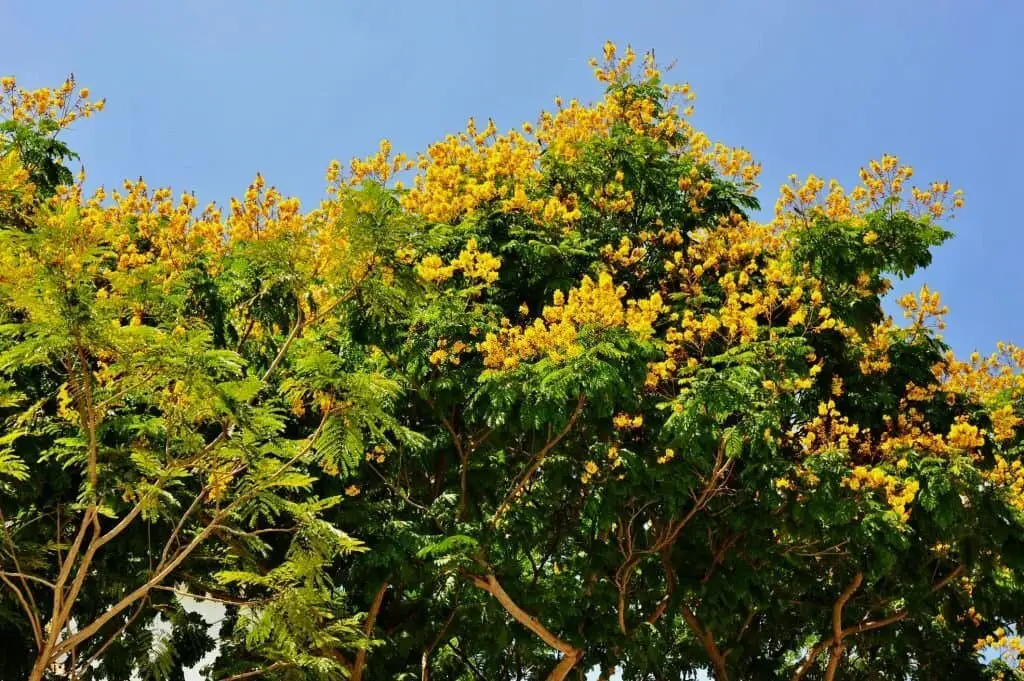
Peltophorum, a genus of flowering plants in the Fabaceae family, derives its name from Greek roots meaning ‘shield’ and ‘bearing.’ This diverse group comprises around 60 species native to tropical and subtropical regions across Africa, Asia, and Oceania. Characterized by compound leaves with numerous small leaflets, Peltophorum members also feature clusters or racemes of typically yellow flowers, although some species display orange or red hues.
One notable species is Peltophorum pterocarpum, a large tree that can reach heights of 30 meters (100 feet) and exhibit a range of features. The trunk often bears buttresses at its base and measures up to 60 centimeters (24 inches) in diameter, with dark brown or black bark that may be smooth or slightly fissured. The compound leaves comprise 20-40 leaflets, while the yellow flowers appear in racemes up to 30 centimeters (12 inches) long.
Fruits take the form of brown or black pods measuring up to 30 centimeters (12 inches) and containing two or three seeds. Native to tropical and subtropical regions, Peltophorum pterocarpum has been introduced to the Americas where it now thrives in many countries.
Cultivated as an ornamental plant and used in traditional medicine, this fast-growing tree prefers full sun, moist, well-drained soils, and is surprisingly tolerant of drought and salt spray – making it a suitable choice for coastal areas.
Sunny Knock Out® Rose Tree (Rosa ‘RADsunny’).
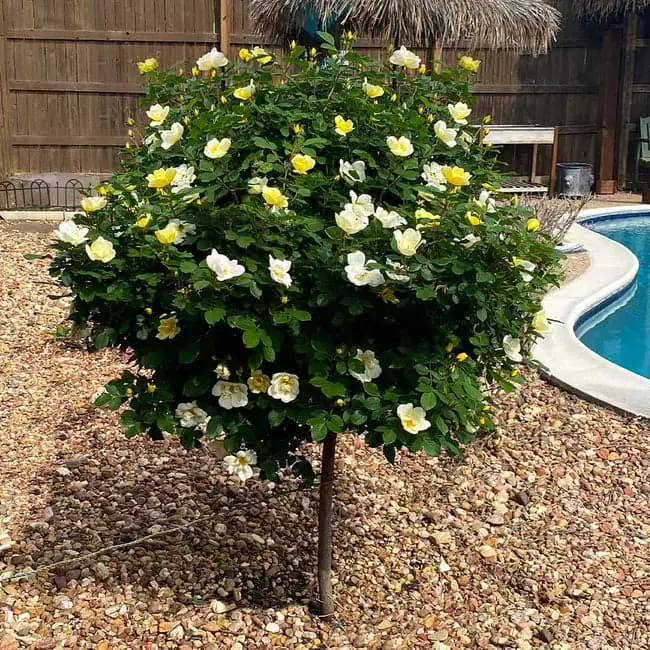
Indulge your senses with the vibrant beauty of this deciduous shrub, which is adorned with radiant yellow blooms throughout the seasons from spring to fall. As a testament to its hardiness, Knock Out roses are renowned for their low-maintenance nature and natural resistance to diseases, rendering them an excellent choice for gardeners with busy schedules.
Sweet Acacia (Vachellia farnesiana).

One of the most striking trees when in bloom, the Sweet Acacia’s small to medium size belies its impressive display of yellow flowers, which are carried throughout the tree and emit a sweet fragrance. This profusion of blooms typically appears in late winter or early spring, lasting several weeks.
Native to Texas and Mexico, this versatile tree has been successfully planted in many regions around the world.
Its adaptability makes it a popular choice for landscaping in warmer climates, thriving in a wide range of soils. Furthermore, its tough nature allows it to withstand extended droughts without water, making it an ideal option for low-maintenance gardening.
This resilient tree can be pruned to maintain a smaller size or left to grow into a medium-sized specimen.
Its utility extends beyond aesthetics, as it also makes an excellent accent or specimen tree, suitable for mass plantings and even planting under power lines.
Tipu Tree (Tipuana tipu).

The Tipu tree, affectionately known as the Pride of Bolivia, stands tall at heights of up to 40 feet, its stunning display of yellow flowers drawing in pollinators like bees throughout the spring and summer months. As the blooms fade, brown pods emerge, each containing a multitude of seeds. Native to Bolivia, this tree can also be found thriving in Argentina, Brazil, Paraguay, and Uruguay, where it prefers full sun and well-drained soils to flourish.
With its ability to withstand drought once established, Tipu trees offer a hardy option for propagation through both seed and cutting methods.
Tulip Poplar (Liriodendron tulipifera).
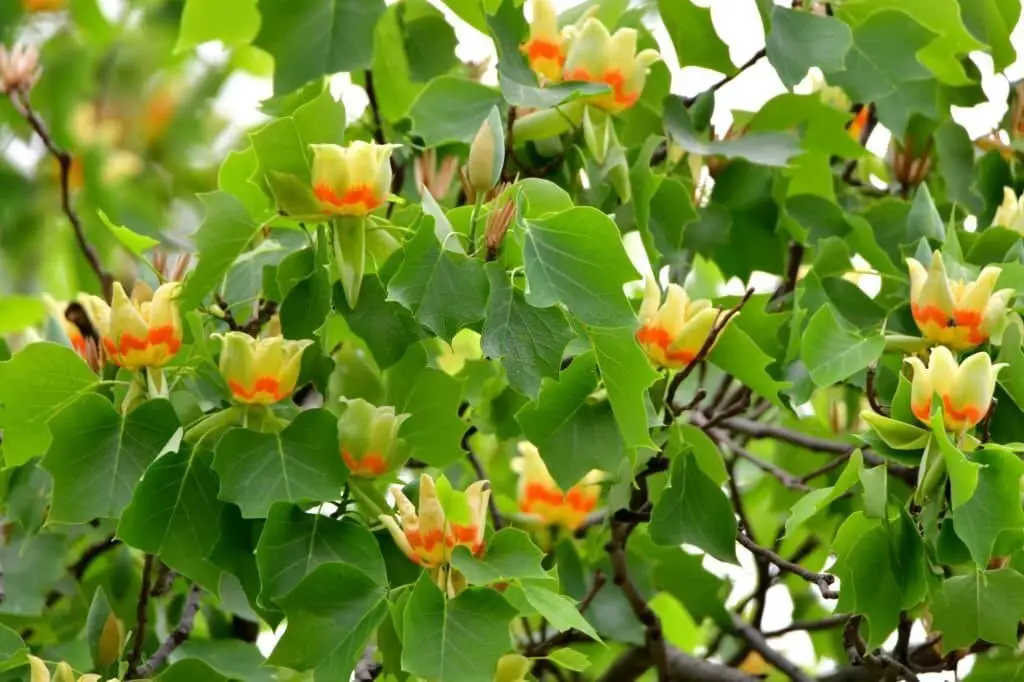
Tulip poplars, with their vibrant yellow blooms and robust fragrances, are a stunning addition to any landscape. These trees thrive in the eastern United States and Canada, where they can grow up to 100 feet tall, making them a popular choice for parks and gardens. As their name suggests, tulip poplars have leaves shaped like tulips, adding an extra layer of visual interest to their overall aesthetic.
The combination of their size, flowers, and foliage makes them a sought-after tree for landscaping purposes.
Witch-Hazel (Hamamelis).
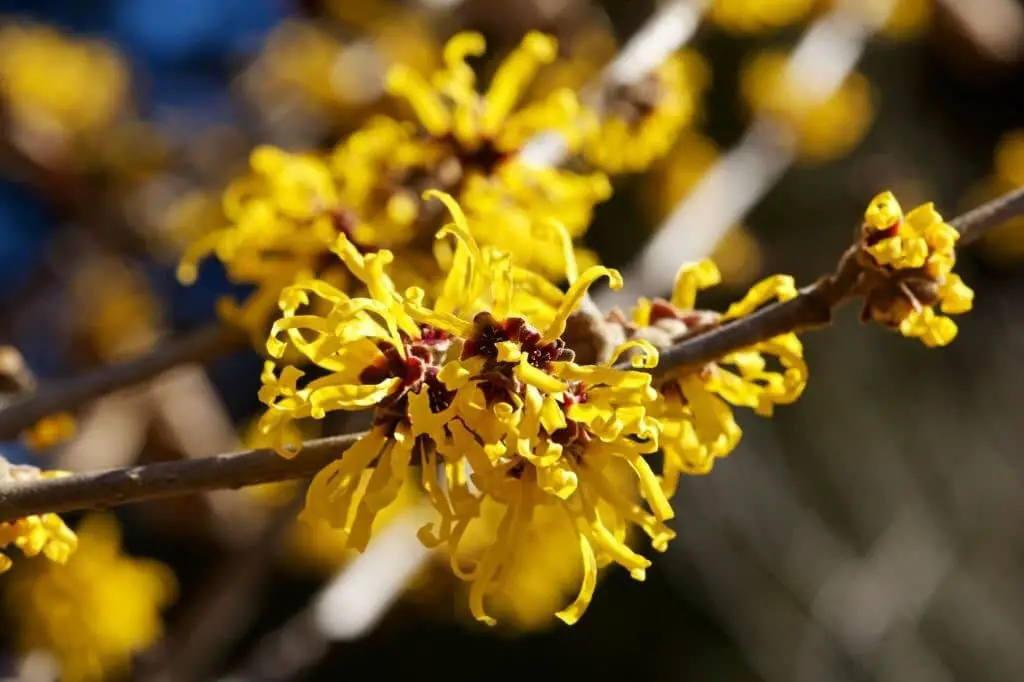
Witch-hazel is a deciduous shrub or small tree that thrives during late fall or early winter when most of the world is already blanketed in snow. Its vibrant yellow blooms burst forth on leafless stems, releasing a potent fragrance that’s hard to miss. As autumn arrives, the witch-hazel’s leaves turn a brilliant shade of yellow before surrendering to the season’s changes.
This adaptable plant has made its way from North America’s native soil to European and global gardens, where it’s cherished for its one-of-a-kind flowers and autumn hues. Its appeal lies not only in its visual charm but also in its role as a trusted ally in traditional medicine.
Witch-hazel’s bark and leaves have been used to craft a soothing tea, touted as a remedy for various ailments including colds, flu, diarrhea, and headaches.
Yellow Buckeye (Aesculus flava).
This tree’s floral displays are characterized by long, upright panicles that can reach up to 18 inches in length. The individual flowers themselves boast a bright yellow or greenish-yellow hue, measuring approximately one inch in diameter. As the seasons transition from early to mid-spring, each bloom typically lasts around two weeks before giving way to new growth.
In contrast, the tree’s fruit production takes place during the fall season, with dark brown, spherical nuts emerging in clusters of two to six and maturing at roughly half an inch in diameter. Beyond their aesthetic appeal, these nuts also serve as a vital food source for various wildlife species. Furthermore, the tree’s wood is renowned for its exceptional quality, boasting a light brown color, heaviness, and remarkable hardness.
As such, it is highly prized for crafting furniture, interior paneling, and other woodworking applications, showcasing the versatility and durability of this remarkable tree’s natural resources.
Yellow Tabebuia (Tabebuia rosea).
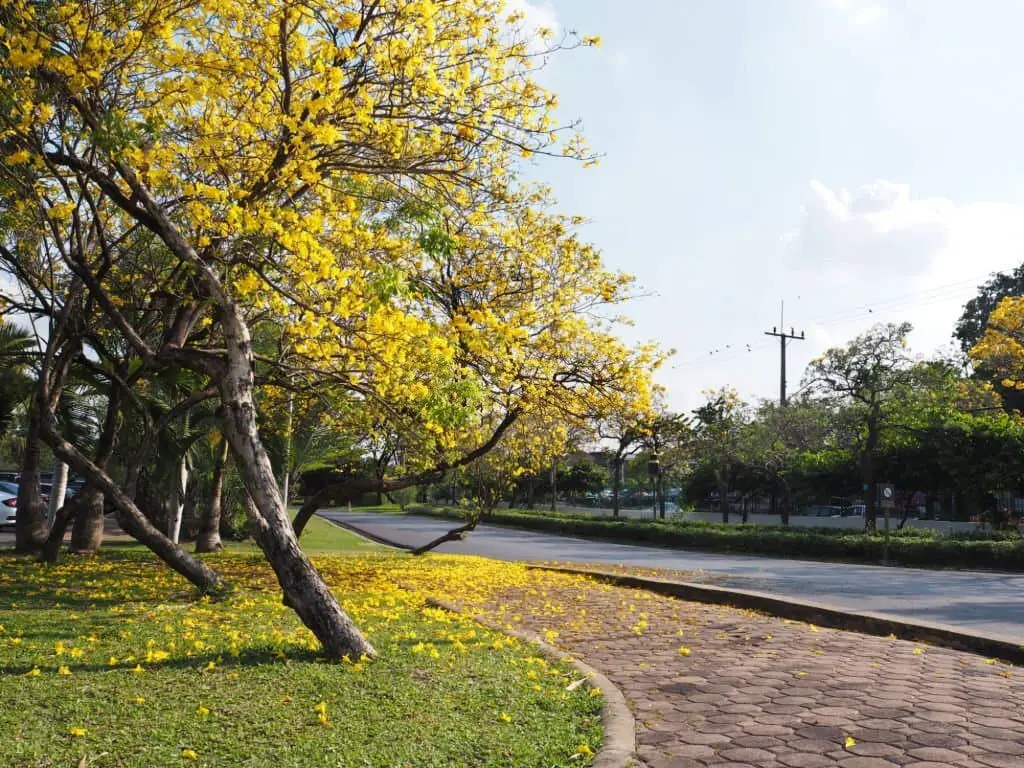
With its striking floral arrangements and distinct fragrance, this tree’s flowers are truly a sight to behold. Additionally, the leaves of the tree undergo a vibrant transformation during the autumn season, boasting a kaleidoscope of colors. Native to Brazil, this tree has gained popularity worldwide for its unique characteristics and aesthetic appeal.
Ylang Ylang Tree (Cananga odorata).
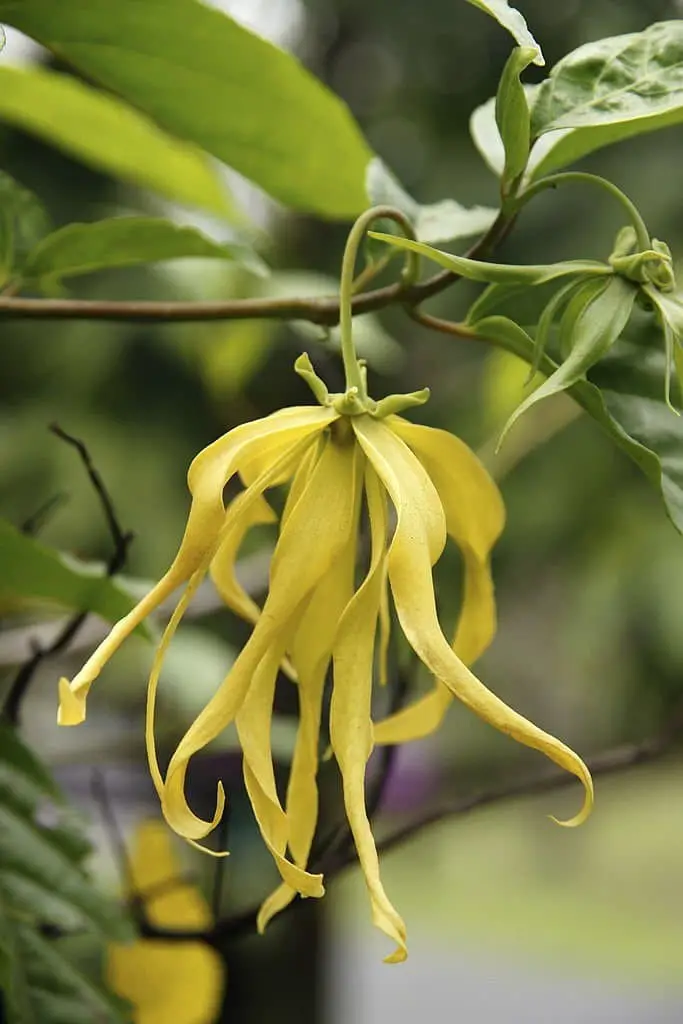
Nestled in the lush landscapes of the Philippines and Indonesia lies the majestic Ylang Ylang tree. Reaching heights of 20-40 meters, its sturdy trunk can grow up to 30-60 centimeters in diameter. The tree’s foliage is characterized by oblong, dark green leaves that exude a sweet fragrance. Amidst this verdant backdrop, bright yellow blooms emerge, each adorned with five delicate petals.
The fruit of the Ylang Ylang tree takes the form of an oval-shaped, woody capsule, which serves as a vessel for its tiny seeds.
Conclusion
When it comes to enhancing the aesthetic appeal of your outdoor space, few options can rival the visual impact of trees with vibrant yellow flowers. These stunning specimens are not only a feast for the eyes but also add an air of sophistication and refinement to any landscape. Whether you’re seeking to beautify your own backyard or searching for a thoughtful gift for a loved one, incorporating one of these radiant trees into your collection is sure to yield a satisfying outcome.
Related Posts
Transforming your outdoor space with a diverse range of online plant nursery offerings. This vast array of flora includes apple trees to evergreens, each offering unique characteristics that can enhance the beauty of your property. For those seeking a career in tree care, becoming an arborist is a viable option. With proper training and experience, arborists play a crucial role in maintaining the health and aesthetic appeal of trees at a property.
Moreover, the impact of trees on a property extends beyond their visual appeal, providing numerous benefits including improved air quality, noise reduction, and enhanced biodiversity. On the flip side, removing certain types of trees can also have a significant effect, much like boosting your home’s curb appeal through strategic pruning or removal of overgrown foliage.
For those looking to cultivate specific plant species, such as the lady palm (Rhapis excelsa), proper growing tips and care are essential for achieving optimal results. Furthermore, exploring organic methods for cultivating blueberry plants in the garden can lead to a bountiful harvest, while also promoting eco-friendly gardening practices.




